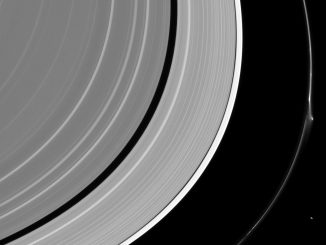
NASA’s Cassini mission ended in 2017 with a deliberate plunge into Saturn’s atmosphere. But data and images captured during the spacecraft’s final, closest-ever passes by the planet’s rings continue to reveal new details about the composition of the system and how small moons gravitationally sculpt ring particles into delicate textures and patterns.
“It’s like turning the power up one more notch on what we could see in the rings,” said Cassini Project Scientist Linda Spilker. “Everyone just got a clearer view of what’s going on. Getting that extra resolution answered many questions, but so many tantalising ones remain.”
The research, appearing in the journal Science, applies not just to the dynamics of Saturn’s rings. It also sheds light on how astrophysical disc form an evolve, including the protoplanetary discs that give rise to entire solar systems.
“These new details of how the moons are sculpting the rings in various ways provide a window into solar system formation, where you also have disks evolving under the influence of masses embedded within them,” said lead author and Cassini scientist Matt Tiscareno of the SETI Institute in Mountain View, California.
In a spectacular mosaic, Saturn’s tiny moon Daphnis can be seen embedded in the rings, its gravity clearing out a region known as the Keeler gap, trailing three waves in the gap’s outer edge. The crests of the waves diminish in size the farther they are from the moon as ring particles interact and collide.

The sculpting generated by Daphnis already was well documented, but the new analysis reveals several previously unseen features, including thin strands of ring material spreading out as the more distant crests diminish and break up. The images making up the mosaic were captured at a distance of about 28,000 kilometres (17,000 miles) from Daphnis.
“This tells us the way the rings look is not just a function of how much material there is,” Tiscareno said. “There has to be something different about the characteristics of the particles, perhaps affecting what happens when two ring particles collide and bounce off each other. And we don’t yet know what it is.”
Cassini’s Visible and Infrared Mapping Spectrometer revealed yet another mystery, finding a surprisingly weak signal for water ice in Saturn’s outermost A ring, a highly reflective region thought to contain relatively uncontaminated ice bands. In addition, no organic compounds were detected and no detectable amounts of ammonia ice or methane ice.
“If organics were there in large amounts, at least in the main A, B and C rings, we’d see them,” said Phil Nicholson, Cassini VIMS scientist of Cornell University. “I’m not convinced yet that they are a major component of the main rings.”



